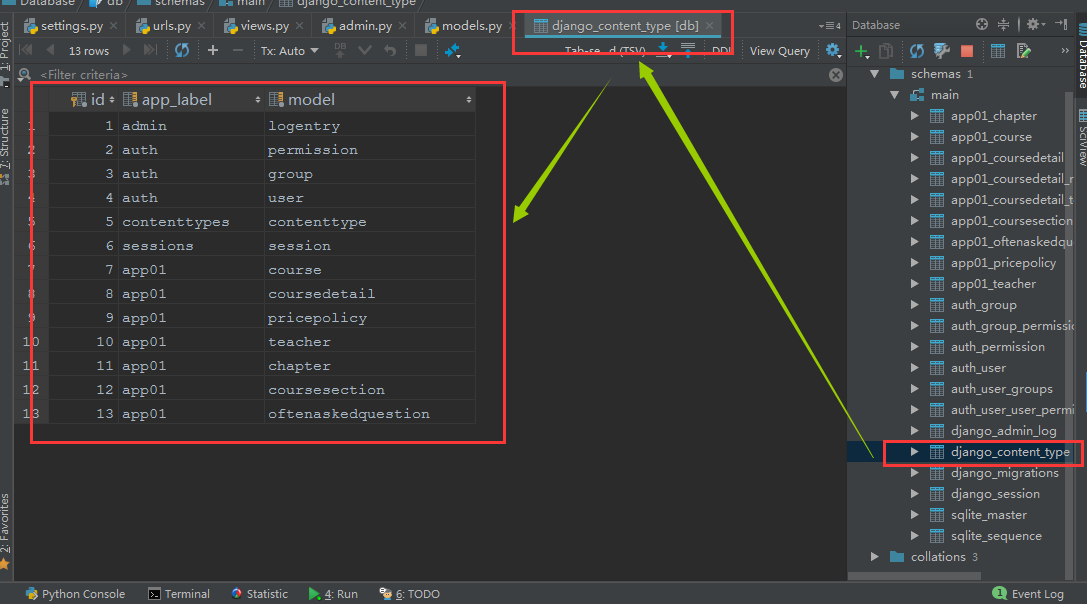contenttypes 是Django内置的一个应用,可以追踪项目中所有app和model的对应关系,并记录在ContentType表中。
每当我们创建了新的model并执行数据库迁移后,ContentType表中就会自动新增一条记录。如下:

那么这个表有什么作用呢?这里提供一个场景,网上商城购物时,会有各种各样的优惠券,比如通用优惠券,满减券,或者是仅限特定品类的优惠券。在数据库中,可以通过外键将优惠券和不同品类的商品表关联起来:
from django.db import models class Electrics(models.Model): """ id name 1 日立冰箱 2 三星电视 3 小天鹅洗衣机 """ name = models.CharField(max_length=32) class Foods(models.Model): """ id name 1 面包 2 烤鸭 """ name = models.CharField(max_length=32) class Clothes(models.Model): name = models.CharField(max_length=32) class Coupon(models.Model): """ id name Electrics Foods Clothes more... 1 通用优惠券 null null null 2 冰箱满减券 1 null null 3 面包狂欢节 null 1 null """ name = models.CharField(max_length=32) electric_obj = models.ForeignKey(to='Electrics', null=True) food_obj = models.ForeignKey(to='Foods', null=True) cloth_obj = models.ForeignKey(to='Clothes', null=True)
如果是通用优惠券,那么所有的ForeignKey为null,如果仅限某些商品,那么对应商品ForeignKey记录该商品的id,不相关的记录为null。但是这样做是有问题的:实际中商品品类繁多,而且很可能还会持续增加,那么优惠券表中的外键将越来越多,但是每条记录仅使用其中的一个或某几个外键字段。
通过使用contenttypes 应用中提供的特殊字段GenericForeignKey,我们可以很好的解决这个问题。只需要以下三步:
- 在model中定义ForeignKey字段,并关联到ContentType表。通常这个字段命名为“content_type”
- 在model中定义PositiveIntegerField字段,用来存储关联表中的主键。通常这个字段命名为“object_id”
- 在model中定义GenericForeignKey字段,传入上述两个字段的名字。
为了更方便查询商品的优惠券,我们还可以在商品类中通过GenericRelation字段定义反向关系。
class Electrics(models.Model): name = models.CharField(max_length=32) price = models.IntegerField(default=100) coupons = GenericRelation(to='Coupon') # 用于反向查询,不会生成表字段 def __str__(self): return self.name class Coupon(models.Model): name = models.CharField(max_length=32) content_type = models.ForeignKey(to=ContentType) # step 1 关联contentype表,使当前表与contenttype中的model的对应 object_id = models.PositiveIntegerField() # step 2 对应model表中的id content_object = GenericForeignKey('content_type', 'object_id') # step 3 (对应的表id,对应的表中的一条数据的id) def __str__(self): return self.name # Coupon对象 - -----》商品对象 coupon_obj.content_object # 商品对象 - -----》Coupon对象 electrics_obj.coupons.all()
GenericRelation反向查,GenericForeignKey正向查,都不会在数据库中生成字段,只是方便查询